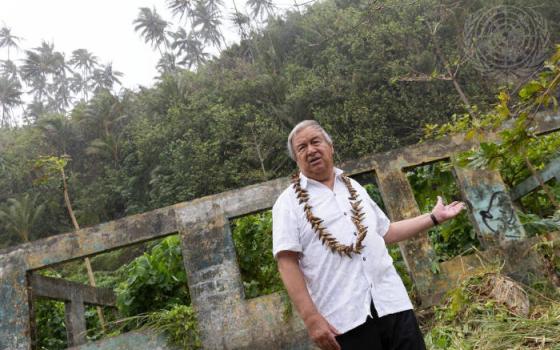
Taysha Martineau of the Fond du Lac tribe is a water protector and has helped build Camp Migizi immediately next to one of the Enbridge Line 3 worksites on the Fond du Lac reservation on a piece of land she and others purchased. She and other water protectors stage actions from the camp and are working to learn traditional Ojibwe ways there. (Photo by Mary Annette Pember, Indian Country Today)
Editor's note: This story originally appeared in Indian Country Today and is republished here as part of Covering Climate Now, a global journalism collaboration strengthening coverage of the climate story.
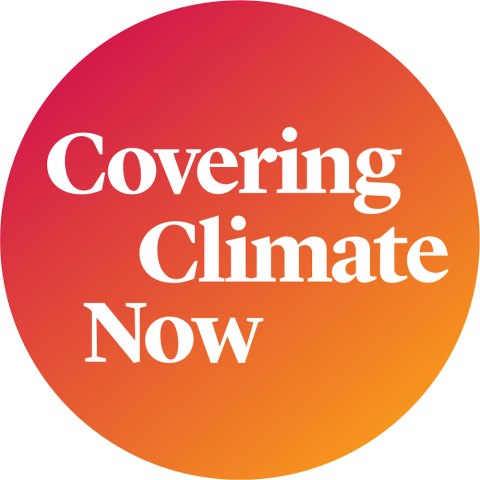
Part 1 of an ongoing series
Jason Goward was overjoyed to get a high-paying job on Enbridge's Line 3 pipeline project.
The job, clearing ground with a contractor for the Canadian energy company, meant he could at last pay child support for his two young sons. He could buy groceries, pay for heat.
And maybe, just maybe, he could dig his way out of poverty.
"I thought if I worked for a couple of years at this, I could finally get ahead a little bit," said Goward, 37, a citizen of the Fond du Lac Band of Ojibwe. "I didn't think about the impact of the pipeline on our lands and way of life."
As he worked along the pipeline, however, he watched sandhill cranes fly over his job site. One of the Ojibwe leadership clans is named after the crane — ajijaak, the ones who speak on behalf of the people. The cranes were frantically fleeing the wetlands at the sound and disturbance of the heavy machinery he operated.
Protesters gathered to oppose the pipeline, shouting at Goward and demanding to know why he was destroying his homelands. He recognized friends among the water protectors, as they are known, friends with whom he has worked on past community projects. One was crying.
And he thought of his young sons, who might one day want to hunt, gather medicines and harvest rice as part of their Ojibwe birthright.
"I had kind of an epiphany," he said. "Maybe I'm not on the right side of this. I began to think of the pipeline's impact on our water and wild rice; that rice is part of the reason Ojibwe came to this area so long ago."
Abruptly, he walked off the job.
"I feel so relieved," he told Indian Country Today. "I had so much guilt, embarrassment and shame hurting my ancestral lands."
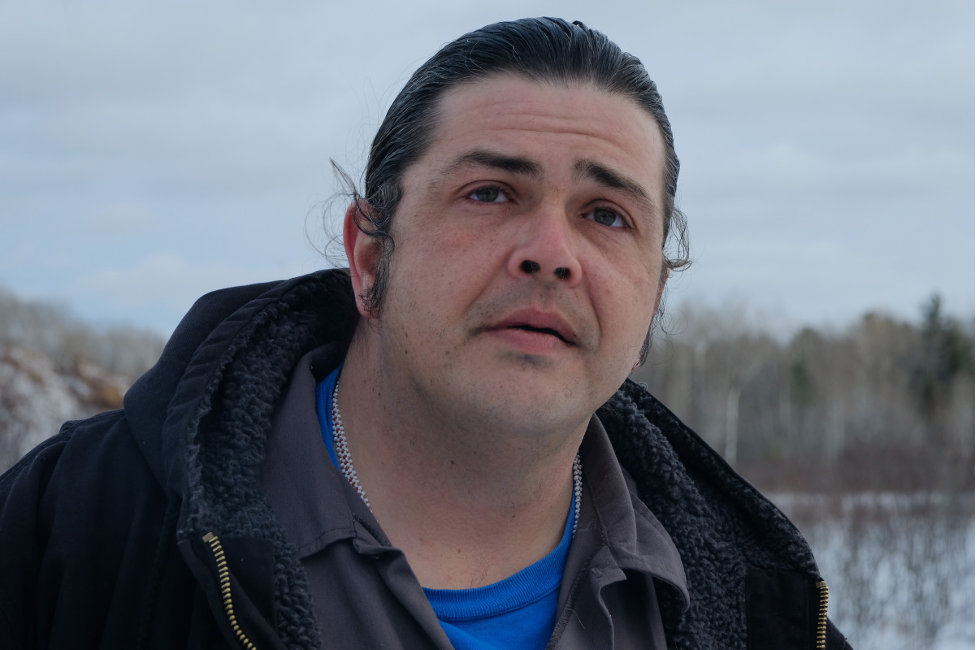
Jason Goward, citizen of the Fond du Lac tribe, quit his job working for construction on Enbridge Line 3 after realizing his was hurting his community and land. (Photo by Mary Annette Pember, Indian Country Today)
It's a conflict facing growing numbers of Native people along Line 3's nearly 400-mile path. As it cuts across the Fond du Lac reservation, treaty lands of several other bands of Ojibwe and the headwaters of the Mississippi River in northern Minnesota, the project has brought not just jobs but controversy and discord into the most intimate spheres of spirituality, family and community.
The friction intensified as Enbridge pumped large sums of money into local communities along the pipeline route through donations, jobs, tax revenues, money for local policing and local advertisements. In the process, the company won support from some local governments, an agreement from at least one tribe not to oppose the project and acceptance from untold tribal members.
The approach is far different from the violent confrontations in 2016 over the Dakota Access pipeline at Standing Rock in North Dakota. There, pipeline owners and law enforcement used rubber bullets, water cannons, tear gas and other tactics against protestors.
"Enbridge leaders know there's no way for them to win the hearts and minds of all the Native people but they don't have to," said Anton Treuer, professor of Ojibwe language at Bemidji State University in Minnesota.
"If they can win over just enough to clear enough hurdles to get the next easement or next little contract or permit approved, they know they'll be able to get their work done."
Enbridge officials say the project has been carefully scrutinized during the regulatory and permitting process, including 70 meetings for public comment, multiple reviews and approval by the U.S. Army Corps of Engineers, the Minnesota Public Utilities Commission and the Minnesota departments of pollution control and commerce. Enbridge leaders point to the thousands of jobs created by the project.

Sections of pipe await placement near Grand Rapids, Minnesota, for the Enbridge Line 3 project. (Photo by Mary Annette Pember, Indian Country Today)
"The replacement of Line 3 is a safety-focused project," said Juli Kellner, a spokesperson for Enbridge. "The project has passed every test…"
Opposition grows as work gets underway
The $2.6 billion Line 3 project – the largest in Enbridge history – is part of the company's Mainline pipeline system, North America's largest oil pipeline that sprawls across Canada, Minnesota, Wisconsin, Michigan, Illinois and Indiana.
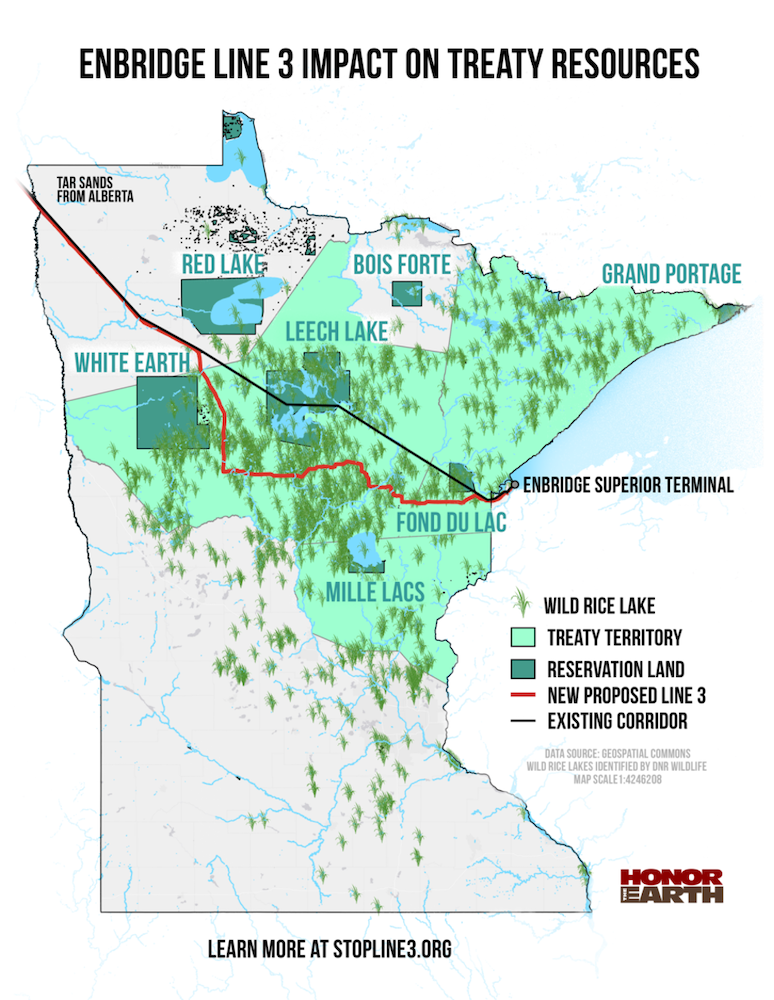
Map of Line 3 route through northern Minnesota. (Photo courtesy of Honor the Earth)
The existing Line 3 corridor was first installed in the 1950s through the Leech Lake and Fond du Lac reservations and treaty lands of the Red Lake, White Earth and Milles Lacs tribes. At the time, the company negotiated easement agreements with the tribes, sometimes for as little as $1,500, in order to run pipelines through reservation lands.
The latest Line 3 project is designed to replace 382 miles of existing 32-inch pipeline with 337 miles of 34-inch pipe with capacity to carry tar sands oil from Alberta, Canada, to Superior, Wisconsin.
The project, first proposed in 2014, received its final permit from the Army Corps of Engineers in November. Work has already begun on laying the new line and the pipeline is set to be completed by the end of the year.
Indigenous, environmental and citizens groups have opposed Line 3 throughout the review process, contending that pipeline construction would damage and pollute fragile waterways and that any future spills would ruin wild rice and other ecosystems in the region.

An eagle nest near the Enbridge Line 3 construction site in northern Minnesota (Photo by Mary Annette Pember, Indian Country Today)
More than a foodstuff, the wild rice, or manoomin, symbolizes the essential cultural connection between land, subsistence gathering and the Ojibwe world view. The act of "making rice" is a tangible expression of the Ojibwe relationship with the earth, one of sustainability and commitment to ensuring resources are protected and available for future generations.
For many, taking part in subsistence activities helps heal the mind and spirit. Goward recalled how traditional Ojibwe ways and teachings helped him seven years ago when he got sober.
"Those ceremonies helped me stay sober and find a healing balance in life," he said. "Our ways were the only things I had to turn to."
In December, the White Earth and Red Lake bands of Ojibwe joined with the Sierra Club and Honor the Earth to file suit in federal court in Washington, D.C., seeking to overturn the Army Corps' permit to Enbridge for Line 3. The lawsuit is pending.
Opposition, meanwhile, is growing as environmental, church and business organizations join the fight. They point to data collected by Greenpeace that shows that Enbridge and its joint ventures and subsidiaries reported 307 incidents involving hazardous liquids between 2002 to 2018, including a 2010 spill in which an Enbridge pipeline dumped 840,000 gallons of tar sands into the Kalamazoo River in Michigan.
Joe Plumer, a citizen of the Leech Lake Band of Ojibwe and attorney for the Red Lake Band, said the Army Corps failed to conduct its own environmental impact study, relying instead on the Minnesota Department of Commerce's review.
"They allowed Enbridge to create their own demand forecast," Plumer said.
Opponents are hoping President Joe Biden could also intervene. The president recently issued an order rescinding the permit for the Keystone XL pipeline and signed a presidential executive order requiring all federal and executive agencies to consult with tribes on projects. Rep. Ilhan Omar, D-Minnesota, recently sent a letter to Biden urging him to stop Line 3. Indeed, a presidential order could halt construction, at least temporarily, until the Army Corps of Engineers conducts its own environmental impact study.
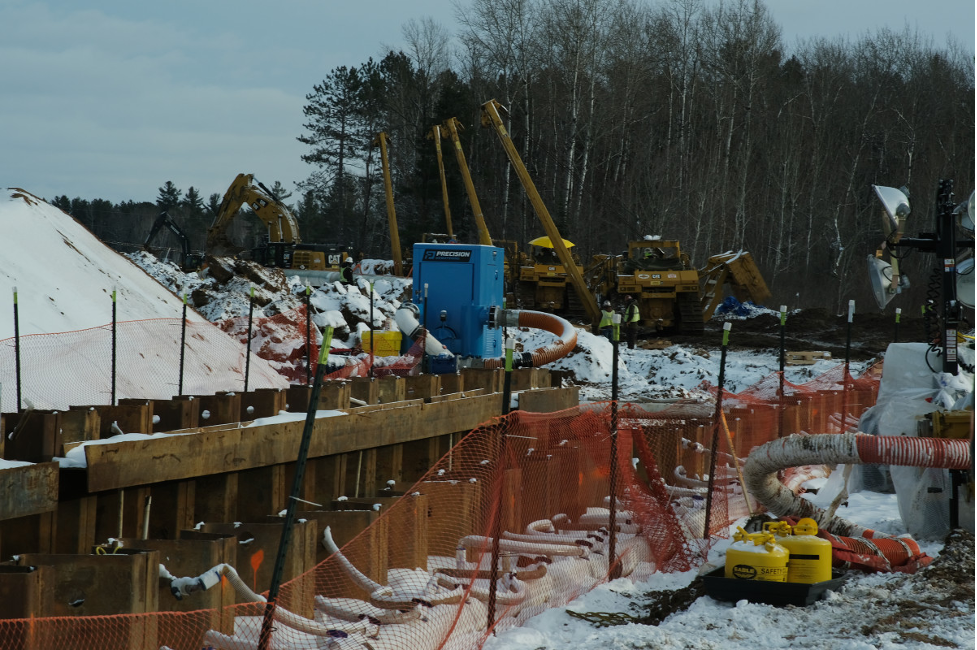
Construction of the Enbridge Line 3 pipeline was underway at the Fond du Lac reservation in Minnesota in February 2021. (Photo by Mary Annette Pember, Indian Country Today)
Legal action is also pending against another Enbridge project known as Line 5. The company is proposing to replace and expand an aging pipeline that runs from Superior, Wisconsin, to Sarnia, Ontario, through treaty and reservation lands of the Bad River Ojibwe, across the Upper Peninsula of Michigan, and under the Straits of Mackinac. Today, the Line 5 pipeline lies on the ocean floor in the Straits of Mackinac, a main shipping lane. The line was struck in 2018 by a ship's anchor, causing damage and raising alarms about the potential for environmental damage.
The Bad River tribe in Wisconsin sued Enbridge in federal court in 2019 demanding the company shut down the Line 5 pipeline and remove existing lines that are part of the original system from reservation lands.
According to the complaint, the existing pipelines are exposed and are at risk of rupturing. Both the Bad River and Kakagon sloughs are considered to be internationally important wetlands and provide habitats for wild rice beds and breeding grounds for lake sturgeon and shorebirds.
Enbridge is now awaiting clean water permits and an environmental impact statement from the Army Corps before moving forward with replacing Line 5; Michigan Gov. Gretchen Whitmer last year ordered Line 5 to be shut down but Enbridge is contesting the decision.
Line 5 also passes through the 1836 treaty lands of the five tribes in Michigan composing the Chippewa Ottawa Resource Authority and include the Grand Traverse Band of Ottawa and Chippewa Indians, the Little River Band of Ottawa Indians, the Little Traverse Bay Bands of Odawa Indians and the Sault Ste. Marie Tribe of Chippewa Indians.
Cash, jobs clash with traditions
The windfall of steady cash and jobs in poor, rural communities comes at a deep personal cost for many.
Taysha Martineau of the Fond du Lac tribe said her work opposing Line 3 may be endangering her tribal citizenship as well as her tribal housing.
Martineau was among the water protectors protesting at Goward's worksite. She had worked with Goward on other projects, and stood in tears at the project.
"Jason's an amazing father and I know he had no other choice but to take the Enbridge job," she said. "I told him, 'Hey, I know you have to feed your kids. I don't hold any hate for you.'
"I told him, 'When I take that line and you're on the other side, don't be afraid of me. I'm also there for you.' Finally, he said, 'I'm not going in; I quit. I'll stand there with you.' It was amazing."
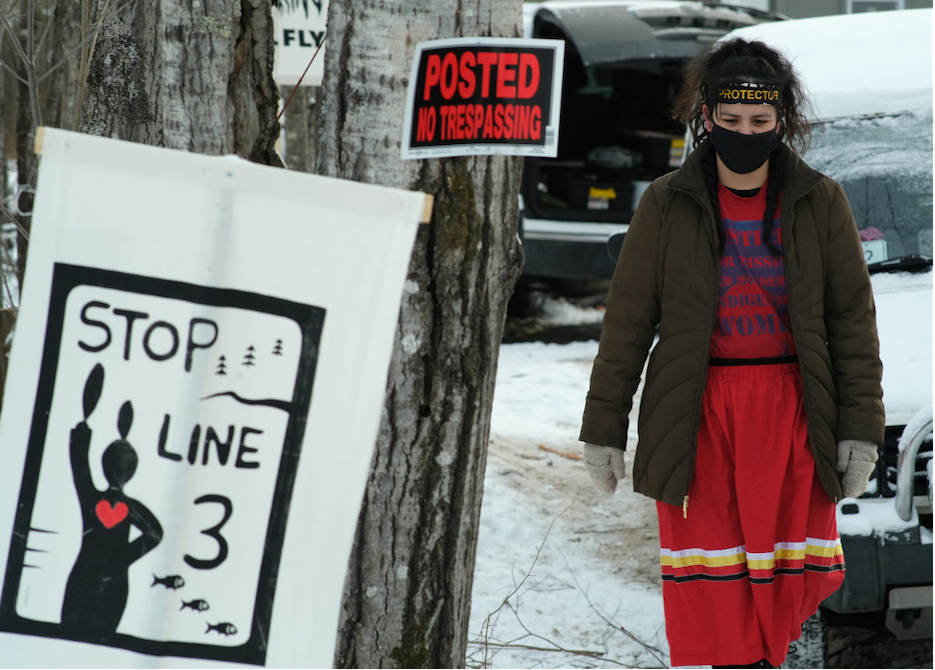
Taysha Martineau of the Fond du Lac tribe of Ojibwe helped purchase and found Camp Migizi on the Fond du Lac reservation. (Photo by Mary Annette Pember, Indian Country Today)
Martineau, 27, a single mother of four, recently bought a parcel of land adjacent to a Line 3 worksite on the Fond du Lac reservation. She and fellow water protectors organized a crowdfunding campaign and purchased the land for $30,000. Now called Camp Migizi, which means eagle in the Ojibwe language, the land is a base for protesters as they organize to stop Line 3.
"The way we're living now is no longer sustainable," she said. "As Indigenous people, we're taught to look seven generations ahead regarding all we do. But as it is now, I can't even promise my 14-month-old son that he will be able to gather wild rice if these pipelines leak.
"I made a promise to my children that I would stop Line 3 and that's what I'm doing."
That vow has put her at odds with the tribe. In 2018, the Minnesota Public Utilities Commission voted to approve the project, including Enbridge's preferred route along the existing pipeline that runs through the reservation. The vote forced the Fond du Lac band into a difficult decision – they could either allow the pipeline to run along its existing route through the reservation or agree to a route south of the reservation that would still cut through 1854 treaty territory, where tribal citizens hunt, fish and gather.

Taysha Martineau and Jason Goward walk down road between Camp Migizi and one of the Enbridge Line 3 work sites on the Fond du lac reservation. (Photo by Mary Annette Pember, Indian Country Today)
The Fond du Lac Band chose to allow Enbridge to follow its existing route through the reservation.
"There is no perfect outcome here," tribal council Chairman Kevin Dupuis Sr. told Minnesota Public News at the time. "All remaining options threaten the environment for all and livelihood of the Indigenous people of Minnesota."
When the Fond du Lac leadership agreed to allow Enbridge to use the existing route, they also agreed not to publicly oppose the project. And that has left Martineau worried that her opposition to Line 3 effectively pits her against the tribe's Reservation Business Committee, the governing body of the Fond du Lac Band.
As sovereign nations, tribes have the right to determine citizenship and services as they see fit. Although Martineau hasn't received any explicit statements from tribal leaders about her home or citizenship, she said she has heard veiled threats, and her family members warn that she is jeopardizing her status in the tribe.
Members of Fond du Lac's business committee declined Indian Country Today's request for comment.
Not all Natives are opposed to the project
Rob Abramowski, a citizen of the Fond du Lac Band, is one of approximately 295 Native Americans employed on the Line 3 project. To him, much of the opposition is based on emotion rather than fact.
"I think a lot of the anger is related to what happened at Standing Rock and the Dakota Access pipeline," he said. "The way they handled the protestors there was wrong."
He believes the Enbridge jobs will provide a stepping stone to better employment, but he worries that some people may get angry with him.
"All I'm trying to do is provide for my family and provide opportunities to other band members," he said. "I don't have any other recourse than that, you know. I'm not trying to harm anybody."
Audrey Tsinnie, a citizen of the Navajo and Grand Portage Chippewa tribes, works as a contract welding inspector on the Line 3 project.
Although her work as a welder and then inspector has taken her all over the country, she and her family have lived in the region for about 20 years.
"In my experience, Enbridge has always been the foremost pacesetter as far as industry standards," she said. "Our job is to make sure nothing defective or substandard is used in the work. I guarantee and promise you that to the best of my ability, this pipeline will never leak. I know that's a strong statement but I scrutinize the work as if my child is going to bed on top of every weld."
Tsinnie understands, however, people's desire to move toward renewable energy.
"I'm all for that but it's not quite developed yet," she said. "It's going to take a compromise to get there. I feel like our people need to understand that."
Advertisement
Enbridge tries new approach to win approval
Since the clashes at Standing Rock drew international attention in 2015 and 2016, pipeline companies appear to be putting a new face toward Indigenous peoples and communities.
For Enbridge, that has meant a series of agreements — mostly secret — that pump money into the communities impacted by Line 3.
"Enbridge is far more strategic and methodical about addressing opposition than they were even a few years ago," said Treuer, the Bemidji professor. "They study and understand tribes, tribal peoples, as well as the protest community. Enbridge realizes that it's difficult for water protectors to maintain the ongoing intense energy and momentum of protest so they engage in different methods for keeping them muted."
He added, "Their strategy has been effective but it's unwise in the long term. New things are happening; we have a new president and new political environment. Resistance against Enbridge is stiffening."
Suparna Chatterjee, associate professor for sustainability and global cultures in the history department and the Williams College of Business at Xavier University in Cincinnati, said the new approach to corporate responsibility works largely on behalf of the company.
"Corporate social responsibility individualizes problems," she said. "But members of vulnerable communities experience a lack of choice over individual problems because of the absolute neglect by the government and years of ignoring their needs.
"These are not individual problems; they are social problems," she said.
For many, the Line 3 project exemplifies the short-term, boom-and-bust economy that has defined white settler goals since Europeans first set foot in America.
Indeed, the first treaty negotiations between Ojibwe and the federal and state governments in the early- to mid-1800s were focused on accessing the massive swaths of Native lands with their valuable stands of timber, minerals and other natural resources in exchange for tribes' immediate needs for cash, goods, food and agricultural supplies.
Ultimately, these exchanges interrupted Ojibwe traditional relationships with sustainable food and supplies, forcing them into the settler economy with little concern for the future.
More recently, in 2018, in exchange for extension of Enbridge's reservation easement through 2039 for the Line 3 project, Enbridge paid the Fond du Lac Band an undisclosed sum and agreed to offer contracting, training and job opportunities for members, according to news reports. Tribal members agreed not to publicly oppose the project.
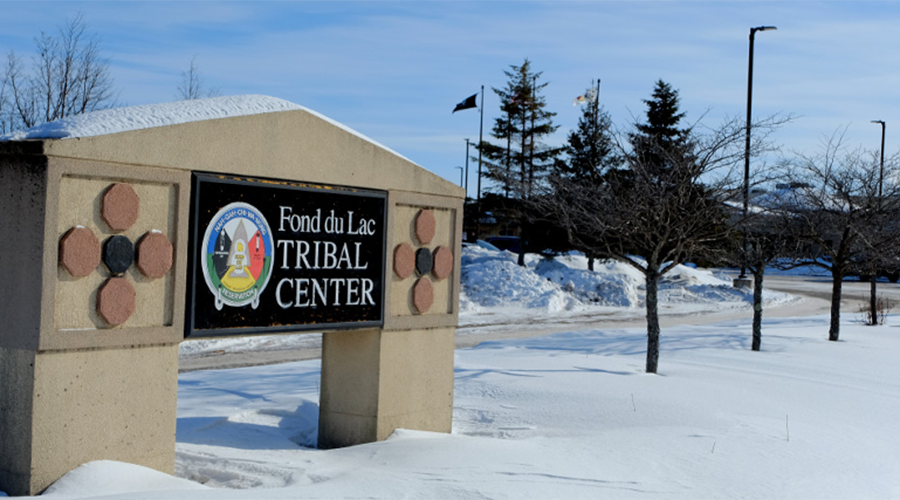
Fond du Lac tribal center in Minnesota (Photo by Mary Annette Pember, Indian Country Today)
Later that year, the Leech Lake Band of Ojibwe also came to an agreement with Enbridge in which the company will remove its existing pipelines and build the new system on lands south of the reservation. Details of the agreement are not public, but the Bemidji Pioneer reported that Enbridge agreed to a broad commitment with the tribe to work on green energy projects.
Neither Kellner, the communications specialist for Enbridge, nor Ben Benoit, environmental director for the Leech Lake Band, provided any specific examples of these green energy projects in response to questions by Indian Country Today.
The funds come at a tough time for tribes as they struggle with the pandemic and economic slowdown. Despite the Fond du Lac reservation's success in leveraging its casino profits, diversifying its businesses and making economic development a priority, many citizens still struggle.
In 2019, before the pandemic struck, the unemployment rate on the reservation was about 10.7 percent with 28.8 percent of families living at or below the federal poverty level, as opposed to 3.5 percent unemployment nationwide and 10.5 percent of U.S. families living at or below the poverty level.
The job market and casino profits suffered even more during 2020 because of the pandemic.
In January, the Fond du Lac tribe sent out a letter to its citizens with the monthly per capita payment check. The letter read in part, "In 2021 the Band will continue to make its per capita payments in the amount of $400.00 per month. The Band will continue to make these payments using Enbridge funds that were deposited in trust with the Department of the Interior."
The letter left some residents wondering if opposition to the pipeline would cut off their resources.
"People are afraid that if they complain too much about the pipeline, they might lose their per cap," Martineau said. "You see some people kind of bowing their heads, not wanting to look at you for fear of getting into confrontations."
She added, "Right now, either you work for the pipeline or you go hungry."
As a tribal citizen, Martineau receives a per capita check partially funded by Enbridge dollars but she refuses to keep it.
"I donate that money to the water protectors," she said. "I just can't reconcile taking it even though I don't have much."
Looking ahead
Goward is among those worried. Since leaving the pipeline job, he has been looking for work but is concerned he could go hungry and lose his home.
"It's been hard," he said. "I have to pay car insurance and mortgage in addition to child support. I don't qualify for food stamps or anything like that."
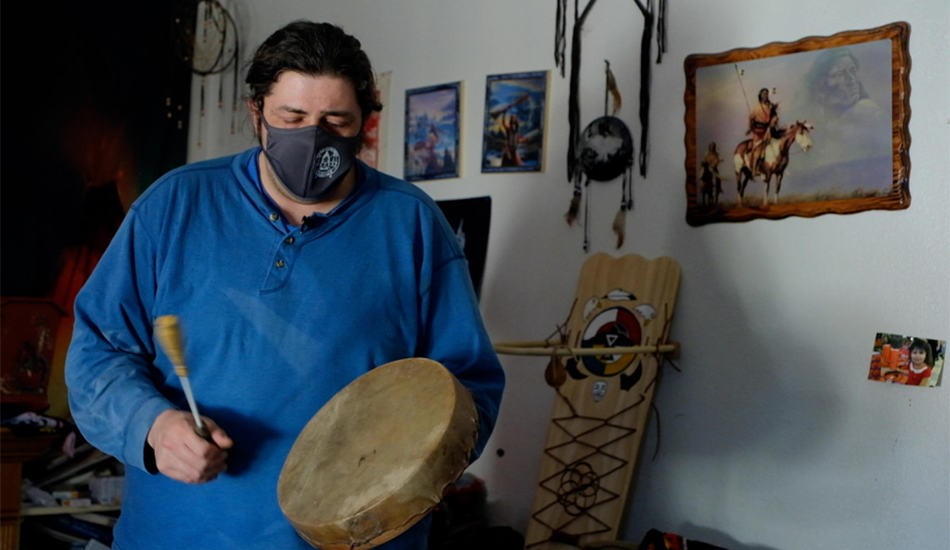
Jason Goward practices traditional Ojibwe hand drum songs. (Photo by Mary Annette Pember, Indian Country Today)
Goward spends his days helping out at Camp Migizi and working with a group advocating for constitutional reform for tribes in Minnesota.
"I babysit; I help organize other groups to come in and support the camp and our struggles," he said. "I help out wherever I can."
Goward also has focused on learning the Ojibwe language and singing traditional hand drum songs, and reconnecting with his culture.
His family is still angry with him for quitting the pipeline job. His teenage son is especially upset.
"His stepdad works on the pipeline and makes good money so he doesn't understand why I made this choice," Goward said.
In the long run, though, Goward believes his actions will send a powerful message to his two sons.
"They might not get it now, but someday when they go out to hunt or make rice they will realize their dad tried to stand up against the pollution and the desecration of Mother Earth," he said.
Now, when Goward returns to the Enbridge construction site where he once worked, he stands with the water protectors, facing his former co-workers with his fist proudly raised in the air.
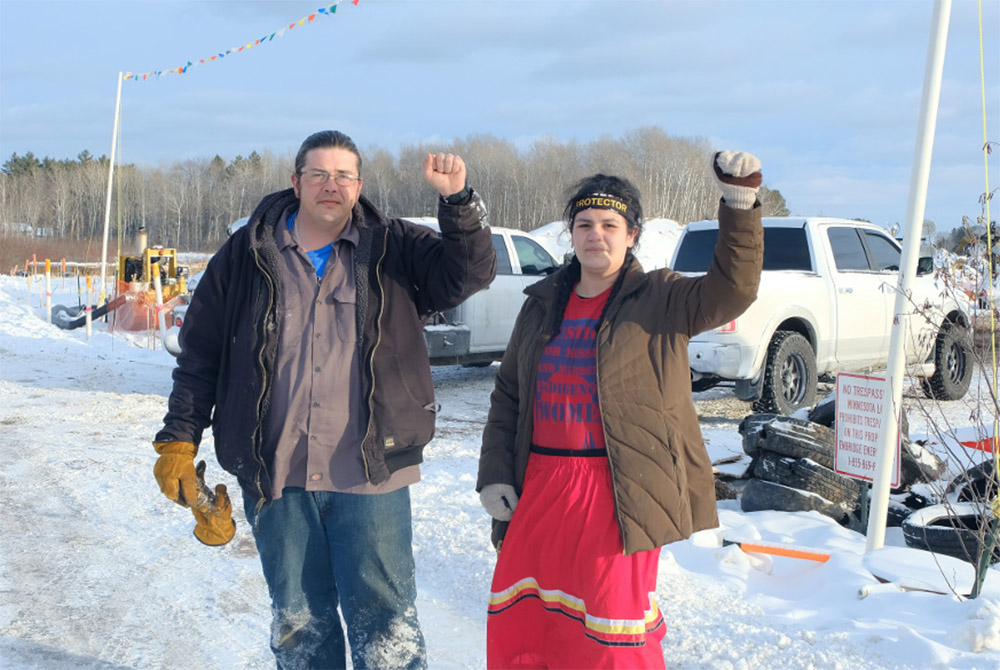
Jason Goward and Taysha Martineau in front of an Enbridge Line 3 worksite on the Fond du lac reservation. (Photo by Mary Annette Pember, Indian Country Today)
Jason Goward and Taysha Martineau in front of an Enbridge Line 3 worksite on the Fond du Lac reservation. (Photo by Mary Annette Pember, Indian Country Today)
"These Enbridge jobs are only going to last a couple of years at the longest," he said. "We'll have to pick up the pieces and go back to working temporary, short-term jobs for minimum wage."
By then, however, Line 3 will be transporting up to 760,000 barrels of oil per day through Minnesota, generating profit for Enbridge for years to come.
[Mary Annette Pember, a citizen of the Red Cliff Ojibwe tribe, is a national correspondent for Indian Country Today.]




